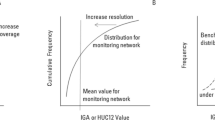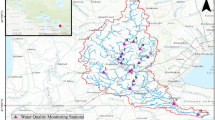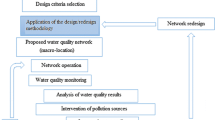Abstract
Assessment of water quality monitoring networks requires potential methods to delineate the efficiency and cost-effectiveness of current monitoring programs. To this end, the concept of entropy has been considered as a promising method in previous studies as it quantitatively measures the information produced by a network. The paper presented discusses an entropy-based approach for the assessment of combined spatial/temporal frequencies of monitoring networks. The results are demonstrated in the case of water quality data observed along the Mississippi River in Louisiana.
Access this chapter
Tax calculation will be finalised at checkout
Purchases are for personal use only
Preview
Unable to display preview. Download preview PDF.
Similar content being viewed by others
References
.National Water Quality Assessment Program: The Challenge of National Synthesis.(1994). Committee on U.S. Geological Survey Water Resources Research, Water Science and Technology Board, National Research Council, National Academy Press, Washington, D.6.
Ward, R.C. (1996). Water quality monitoring: Where’s the beef? AWRAWater Resources Bulletin32(4), 673–680.
Ward, R.C., J.C. Loftis and G.B. McBride (1994).Design of Water Quality Monitoring SystemsVan Nostrand Reinhold, New York.
WMO (1994).Advances in Water Quality Monitoring - Report of a WMO Regional Workshop (Vienna 7–11 March 1994). World Meteorological Organization, Technical Reports in Hydrology and Water Resources, No. 42, WMO/TD-NO 612, Geneva, Switzerland, 332 p.
Adriaanse, M.J., van de Kraats, J., Stoks, P.G., and Ward, R.C. (1995). Conclusions monitoring tailor made. In:Proceedings Monitoring Tailor-Made An International Workshop on Monitoring and Assessment in Water Management, Beekbergen, The Netherlands, Sept. 20–23, pp. 20–23.
Niederlander, H.A.G., Dogterom, J., Buijs, P.H.L., Hupkes, R., and Adriaanse, M. (1996).UN/ECE Task Force on Monitoring & Assessment, Working Programme 1994/1995, Volume:5: State of the Art on Monitoring and Assessment of RiversRIZA report: 95.068.
Harmancioglu, N.B. and Alpaslan, M.N. (1997). Redesign of water quality monitoring networks. In: J.C. Refsgaard and E.A. Karalis (eds.)Operational Water ManagementA.A. Balkema, Rotterdam, pp.57–64.
Sanders, T.G., Ward, R.C., Loftis, J.C., Steele, T.D., Adrian, D.D., and Yevjevich, V. (1983).Design of Networks for Monitoring Water Quality, Water Resources Publications, Littleton, Colorado, 328p.
Tirsch, F.S., & Male, J.W. (1984). River basin water quality monitoring network design. In T.M. Schad (ed.)Options for Reaching Water Quality Goals, Proceedings of the Twentieth Annual Conference of American Water Resources AssociationAWRA Publications, pp:149–156)..
Dixon, W., and Chiswell, B. (1996). Review of aquatic monitoring program design.Water Research30(9), 1935–1948.
Harmancioglu, N.B., Ozkul, S.D. and Alpaslan, M.N. (1998). Water quality monitoring and network design. In: N.B.Harmancioglu, V.P.Singh and M.N. Alpaslan (eds.)Environmental Data ManagementKluwer Academic Publishers, Water Science & Technology Library, vol.27, ch.4, pp.61–106.
Ward, R.C. and Loftis, J.C. (1986). Establishing statistical design criteria for water quality monitoring systems: Review and synthesis.Water Resources Bulletin AWRA 22(5), 759–767.
Schilperoort, T., and Groot, S. (1983) Design and optimization of water quality monitoring networks. Paper presented at theInternational Symposium on Methods and instrumentation for the Investigation of Groundwater Systems (MUGS)Noordwijkerhout, the Netherlands, May 1982, publication no.286.
Jager, H.I., Sale, M.J. and Schmayer, R.L. (1990). Cokriging to assess regional stream quality in the Southern Blue Ridge Province.Water Resources Research26(7), 1401–1412.
Smith, R.A., Schwarz, G.E. and Alexander, R.B. (1997). Regional interpretation of water quality monitoring data.Water Resources Research33(12), 2781–2798.
Esterby, S.R. (1986) Spatial heterogeneity of water quality parameters. In: A.H. Shaarawi and R.E. Kwiatkowski (eds.)Statistical Aspects of Water Quality MonitoringElsevier, pp. 1–16.
Moss, M.E. (1989). Water quality data in the information age. In: R.C. Ward, J.C. Loftis, and G.B. McBride (eds.)Proceedings International Symposium on the Design of Water Quality Information SystemsFort Collins, CSU Information Series No. 61, pp. 8–15.
Husain, T. (1989). Hydrologic uncertainty measure and network design. AWRAWater Resources Bulletin25, 527–534.
Harmancioglu. N. (1981). Measuring the information content of hydrological processes by the entropy concept.Ege University Journal of the Civil Engineering Faculty,Special Issue for the Centennial of Ataturk’s birthIzmir, pp. 13–40.
Harmancioglu, N.B., and Alpaslan, N. (1992). Water quality monitoring network design: A problem of multi-objective decision makingAWRA Water Resources BulletinSpecial Issue on “Multiple Objective Decision Making in Water Resources”, 28(1), 179–192.
Krstanovic. P.F., & Singh, V.P. (1993). Evaluation of rainfall networks using entropy: I.Theoretical development; Il. Application.Water Resources Management6, 279–314.
Moss, M.E. (1997). On the proper selection of surrogate measures in the design of data collection networks. In: N.B. Harmancioglu, M.N. Alpaslan, S.D. Ozkul and V.P. Singh (eds.)Integrated Approach to Environmental Data Management SystemsKluwer Academic Publishers, NATO ASI Series, 2. Environment, vol. 31, pp.79–88.
Yang, Y. and Burn, D.H. (1994). An entropy approach to data collection network designJournal of Hydrology157, 307–324.
Shannon, C.E., & Weaver, W. (1949).The Mathematical Theory of Communication.Urbana, Illinois, The University of Illinois Press.
Amorocho, J., and Espildora, B. (1973). Entropy in the assessment of uncertainty of hydrologic systems and modelsWater Resources Research9, 1511–1522.
Chapman, T.G. (1986). Entropy as a measure of hydrologic data uncertainty aiid model performance.Journal of Hydrology,85, II 1–126.
Ozkul, S. (1996).Space/Time Design of Water Quality Monitoring Networks by the Entropy Method.Dokuz Eylul University,, Graduate School of Natural and Applied Sciences, Izmir, Ph. D. Thesis in Civil Engineering (Advisor: Nilgen B. Harmancioglu).
Author information
Authors and Affiliations
Editor information
Editors and Affiliations
Rights and permissions
Copyright information
© 2003 Springer Science+Business Media Dordrecht
About this chapter
Cite this chapter
Harmancioglu, N.B., Ozkul, S.D. (2003). Entropy-based design considerations for water quality monitoring networks. In: Harmancioglu, N.B., Ozkul, S.D., Fistikoglu, O., Geerders, P. (eds) Integrated Technologies for Environmental Monitoring and Information Production. Nato Science Series, vol 23. Springer, Dordrecht. https://doi.org/10.1007/978-94-010-0231-8_10
Download citation
DOI: https://doi.org/10.1007/978-94-010-0231-8_10
Publisher Name: Springer, Dordrecht
Print ISBN: 978-1-4020-1399-7
Online ISBN: 978-94-010-0231-8
eBook Packages: Springer Book Archive




